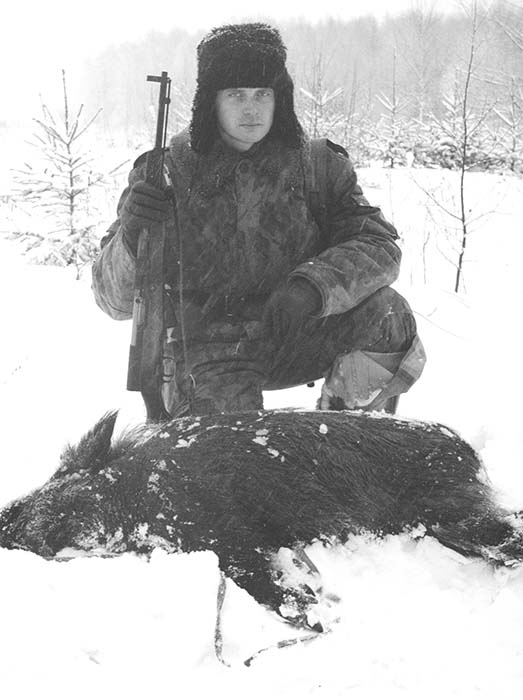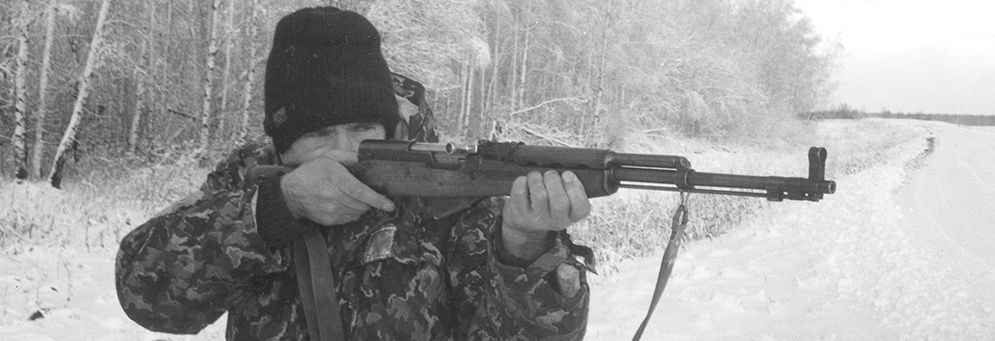By Vadim Ribakov
Born for battle in 1945, the SKS self-loading carbine was adopted by the Soviet Army in 1949. Simonov’s brainchild proved reliable, rapid firing, and easy to operate. For maneuvering armies, the compact semiautomatic was lightweight and capable of delivering mid-range fire to a maximum distance of 600-800 meters. But aside from its battle worthy qualities, the SKS carbine was chiefly designed to utilize the recently developed 7.62x39mm ammunition round.
Dubbed “round sample 1943”, the history of this intermediate cartridge and creation of Simonov’s compact rifle go hand in hand. Previous attempts had been made to create or modify weapons based on the current 7.62x54R round, but the round itself was problematic. Too heavy, too powerful, its broad-rimmed case caused stoppages due to a failure to feed. Dissatisfied and embroiled in the Great War, the Army urgently sought an improved cartridge. An intermediate round with ballistics, mass, and dimensions that lay between the 54R and 25mm pistol – the basic calibers at the time.
In 1943, N.M. Elizarov and B.V. Semin designed the 7.62x39mm round to fulfill the needs of the troops. With a bullet weight of 7.9 grams (122 grains), the steel-cored conventional ball had a maximum range of 1,000 meters. Design of mid-velocity (735 meters/second / 2411 fps) gave the round an inherent arched trajectory. During testing the bullet was fired into, and successfully defeated, three pine boards, each board 2.25cm (1 inch) in thickness.

The emergence of the 7.62x39mm broadened the development of new firearms. Reducing the rim to equal the diameter of the cartridge body simplified the construction of a feed mechanism. The lighter round also produced less recoil, thus improving accuracy and marksmanship. These benefits enabled S.G. Simonov to produce a carbine based on his 7.62 caliber semiautomatic rifle, the AVS-36. Upon meeting all requirements, the Soviet Army adopted the Simonov SKS. Other designs utilizing the 39mm appeared, most notably the Kalashnikov AK (avtomat Kalashnikova). The AK possessed similar ballistics, but had better battle qualities and soon replaced the SKS. Despite Simonov’s modifications, production of the SKS ceased. Stockpiled in warehouses, the mass-produced SKS slowly made its way onto the shelves of local gun shops and into the hands of Russian hunters. Eventually the Government interceded; passing a law that banned the military weapon from citizen possession. To meet the demand, the OP-SKS carbine was released for broad distribution.
Designated “OP” for the hunting trade, the semi-auto battle variant boasts minimal alterations. The bayonet and bracket hardware was removed. An identification “pin” was implanted in the barrel. Protruding above the grooves, this bit of metal scores a unique mark on every fired round. This notch is a specific identifier of each hunting carbine. The original “battle condition” SKS remains widely available on USA and foreign markets.
The uniform single-piece stock is constructed of birch or multi-layer plywood. The diminutive size of the carbine is designed for the average person, with an allowance for heavy outer winter wear. Installing a rubber shock absorber (recoil pad) can easily increase length of the butt stock. A removable bracket is required to mount optics.
Operating Principles of OP-SKS
The self-loading action operates on a gas system. Upon discharge, propellant gases are introduced into a gas tube through the barrel orifice. Pressure of gases sequentially drives back the gas piston, driving rod, and bolt assembly. Bolt carrier prongs engage the housing, travel rearward on longitudinal grooves, and overcome the recoil spring.
Housing contains firing pin, extractor, and cocks the hammer. Channels depress magazine lip for feeding of cartridges. The ejector is located on left side of receiver. Energy of gases is spent in operation of these mechanisms.
Trigger assembly is designed for semiautomatic only. On trigger pull, the hammer and spring are released by the sear. A supplemental disconnector prevents double firing.
In comparison with Saiga and Vepr receiver-mounted safeties, the flag-shaped trigger safety of OP-SKS is desirable for hunting purposes due to its smooth, quiet action.
Magazine is integral and holds 10 rounds. Ammunition is top loaded, utilizing stripper clips that are guided by the vertical notch located on the bolt carrier. When the magazine is emptied, both catch located in the receiver locks bolt assembly rearward, signaling need to reload.
Open sights allow for accurate fire up to 300 meters
For hunting with the OP-SKS carbine, 3 types of Russian production 7.62x39mm ammunition is available. The conventional ball (FMJ) round is comprised of steel and bimetal, generally lacquered for rust protection with a bullet weight of 7.9 grams (122 grains). Also 2 expanding semi-jacketed rounds with bullet weights of 8 grams (123 grains), 9.7 grams (150 grains) are available.
Typically, the non-deforming hardball ammunition cuts into animal flesh with minimal damage, yet does not over-penetrate. This round is preferable for hunting small sized game such as foxes and wolves. The heavy 9.7 gram semi-jacketed round deforms on impact. It is effective up to 100-150 meters on larger animals (weight of 100-150 kg) such as wild goat, small boar, deer and elk calves. Beyond this range, its effectiveness drops dramatically. The 8 gram hunting cartridge contains a distinct hollow point bullet, but the material composition is identical to the sample 1943 round. The mid-weight HP deforms and fragments, causing immediate incapacitation at distances of up to 300 meters. This round is suited for hunting large game at longer ranges.
Today, Russian manufacture of copper-jacketed ammunition is available for the 7.62 caliber. Hunting cartridges, as well as SKS carbines are mass exported from Russia into countries such as USA, Austria, Finland, Sweden and Yugoslavia. Accessories for the SKS are numerous and are listed in nearly every supply catalog. After market items include bipods that mount onto the bayonet bracket, various plastic and fiberglass stocks, flash hiders, high capacity magazines and integrated mount optics.
In summation, the SKS / OP-SKS boasts virtues of simplicity, and reliability under any conditions. Lightweight and good ballistic performance combined with a reasonable price, these firearms are attractive to both hunters and carbine fans alike.
| This article first appeared in Small Arms Review V4N8 (May 2001) |











